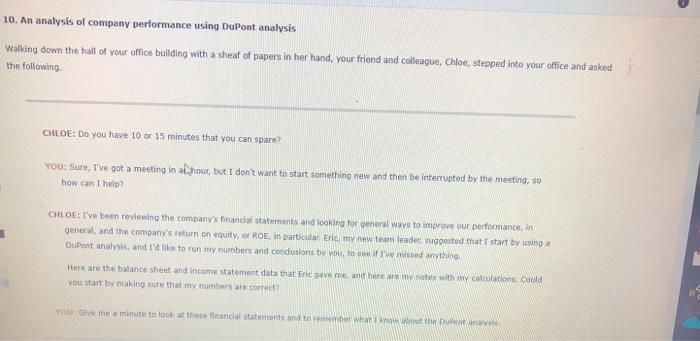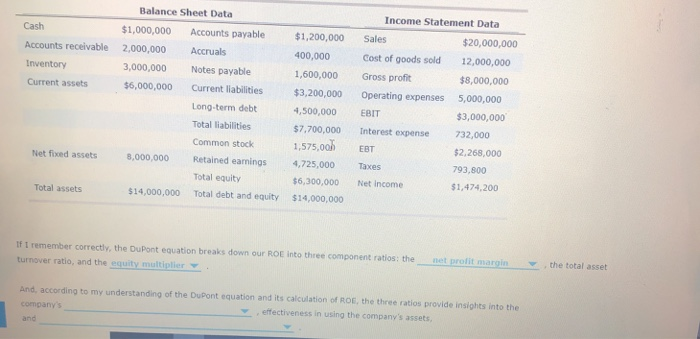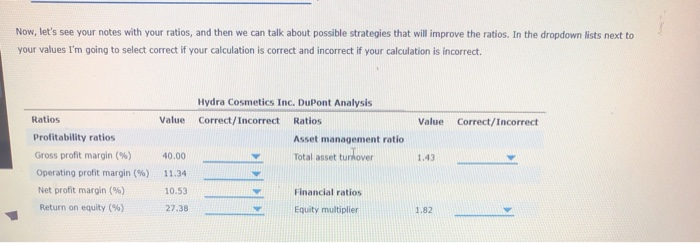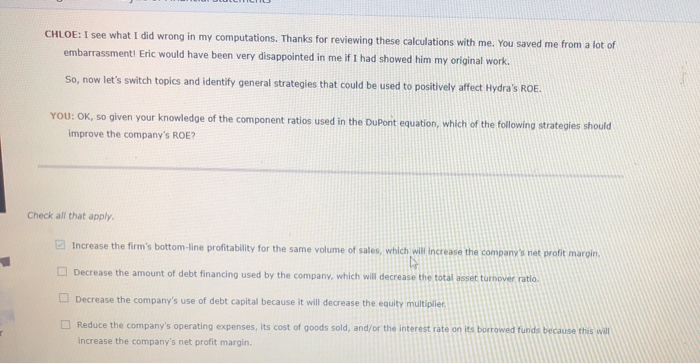10. An analysis of company performance using DuPont analysis Walking down the hall of your office building with a sheaf of papers in her hand, your friend and colleague, Chloe, stepped into your office and asked the following. CHLOE: Do you have 10 or 15 minutes that you can spare? YOU: Sure, I've got a meeting in al hour, but I don't want to start something new and then be interrupted by the meeting, so how can I help? CHLOE: I've been reviewing the company's financial statements and looking for general ways to improve our performance, in general, and the company's return on equity, or ROE, in particular. Eric. my new team leader, suggested that I start by using a DuPont analysis, and l'd like to run my numbers and condusions by you, to see if I've missed anything. Here are the balance sheet and income statement data that Eric gave me, and here are my notes with my calculations. Could you start by making sure that my numbers are correct? YOU: Give me a minute to look at these financial statements and to remember what 1knowbout the DuPont analysi Balance Sheet Data Income Statement Data Cash $1,000,000 Accounts payable $1,200,000 Sales $20,000,000 Accounts receivable 2,000,000 Accruals 400,000 Cost of goods sold 12,000,000 Inventory 3,000,000 Notes payable 1,600,000 Gross profit $8,000,000 Current assets $6,000,000 Current liabilities $3,200,000 Operating expenses 5,000,000 Long-term debt 4,500,000 EBIT $3,000,000 Total liabilities $7,700,000 Interest expense 732,000 1,575,00 Common stock EBT $2,268,000 Net fixed assets Retained eamings 8,000,000 4,725,000 Taxes 793,800 Total equity $6,300,000 Net income $1,474,200 Total assets $14,000,000 Total debt and equity $14,000,000 If I remember correctly, the DuPont equation breaks down our ROE into three component ratios: the net profit margin the total asset turnover ratio, and the equity multiplier And, according to my understanding of the DuPont equation and its calculation of ROE, the three ratios provide insights into the ,effectiveness in using the company's assets, company's and Now, let's see your notes with your ratios, and then we can talk about possible strategies that will improve the ratios. In the dropdown lists next to your values I'm going to select correct if your calculation is correct and incorrect if your calculation is incorrect. Hydra Cosmetics Inc. DuPont Analysis Value Ratios Correct/Incorrect Ratios Value Correct/Incorrect Profitability ratios Asset management ratio Gross profit margin (%) Total asset tunkover 40.00 1.43 Operating profit margin (%) 11.34 Net profit margin (%) 10.53 Financial ratios Return on equity (% ) 27.38 Equity multiplier 1.82 Note: Do not round intermediate calculations. Round final answers to the nearest whole number Hydra Cosmetics Inc. DuPont Analysis Calculation Value Profitability ratios Numerator Denominator Gross profit margin (%) Operating profit margin (%) Net profit margin (%) Return on equity (%) Asset management ratio Total asset turnover Financing ratios Equity multiplier CHLOE: I see what I did wrong in my computations. Thanks for reviewing these calculations with me. You saved me from a lot of embarrassment! Eric would have been very disappointed in me if I had showed him my original work. So, now let's switch topics and identify general strategies that could be used to positively affect Hydra's ROE. YOU: OK, so given your knowledge of the component ratios used in the DuPont equation, which of the following strategies should improve the company's ROE? Check all that apply Increase the firm's bottom-line profitability for the same volume of sales, which will increase the company's net profit margin, Decrease the amount of debt financing used by the company, which will decrease the total asset turnover ratlo. Decrease the company's use of debt capital because it will decrease the equity multiplier Reduce the company's operating expenses, its cost of goods sold, and/or the interest rate on its borrowed funds because this will increase the company's net profit margin. 10. An analysis of company performance using DuPont analysis Walking down the hall of your office building with a sheaf of papers in her hand, your friend and colleague, Chloe, stepped into your office and asked the following. CHLOE: Do you have 10 or 15 minutes that you can spare? YOU: Sure, I've got a meeting in al hour, but I don't want to start something new and then be interrupted by the meeting, so how can I help? CHLOE: I've been reviewing the company's financial statements and looking for general ways to improve our performance, in general, and the company's return on equity, or ROE, in particular. Eric. my new team leader, suggested that I start by using a DuPont analysis, and l'd like to run my numbers and condusions by you, to see if I've missed anything. Here are the balance sheet and income statement data that Eric gave me, and here are my notes with my calculations. Could you start by making sure that my numbers are correct? YOU: Give me a minute to look at these financial statements and to remember what 1knowbout the DuPont analysi Balance Sheet Data Income Statement Data Cash $1,000,000 Accounts payable $1,200,000 Sales $20,000,000 Accounts receivable 2,000,000 Accruals 400,000 Cost of goods sold 12,000,000 Inventory 3,000,000 Notes payable 1,600,000 Gross profit $8,000,000 Current assets $6,000,000 Current liabilities $3,200,000 Operating expenses 5,000,000 Long-term debt 4,500,000 EBIT $3,000,000 Total liabilities $7,700,000 Interest expense 732,000 1,575,00 Common stock EBT $2,268,000 Net fixed assets Retained eamings 8,000,000 4,725,000 Taxes 793,800 Total equity $6,300,000 Net income $1,474,200 Total assets $14,000,000 Total debt and equity $14,000,000 If I remember correctly, the DuPont equation breaks down our ROE into three component ratios: the net profit margin the total asset turnover ratio, and the equity multiplier And, according to my understanding of the DuPont equation and its calculation of ROE, the three ratios provide insights into the ,effectiveness in using the company's assets, company's and Now, let's see your notes with your ratios, and then we can talk about possible strategies that will improve the ratios. In the dropdown lists next to your values I'm going to select correct if your calculation is correct and incorrect if your calculation is incorrect. Hydra Cosmetics Inc. DuPont Analysis Value Ratios Correct/Incorrect Ratios Value Correct/Incorrect Profitability ratios Asset management ratio Gross profit margin (%) Total asset tunkover 40.00 1.43 Operating profit margin (%) 11.34 Net profit margin (%) 10.53 Financial ratios Return on equity (% ) 27.38 Equity multiplier 1.82 Note: Do not round intermediate calculations. Round final answers to the nearest whole number Hydra Cosmetics Inc. DuPont Analysis Calculation Value Profitability ratios Numerator Denominator Gross profit margin (%) Operating profit margin (%) Net profit margin (%) Return on equity (%) Asset management ratio Total asset turnover Financing ratios Equity multiplier CHLOE: I see what I did wrong in my computations. Thanks for reviewing these calculations with me. You saved me from a lot of embarrassment! Eric would have been very disappointed in me if I had showed him my original work. So, now let's switch topics and identify general strategies that could be used to positively affect Hydra's ROE. YOU: OK, so given your knowledge of the component ratios used in the DuPont equation, which of the following strategies should improve the company's ROE? Check all that apply Increase the firm's bottom-line profitability for the same volume of sales, which will increase the company's net profit margin, Decrease the amount of debt financing used by the company, which will decrease the total asset turnover ratlo. Decrease the company's use of debt capital because it will decrease the equity multiplier Reduce the company's operating expenses, its cost of goods sold, and/or the interest rate on its borrowed funds because this will increase the company's net profit margin











